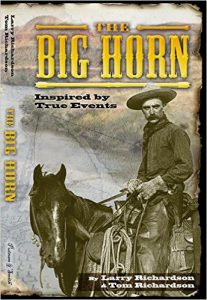Review
=======
 Title: The Big Horn
Title: The Big Horn
Authors: Larry Richardson & Tom Richardson
Publisher: Putnam & Smith
Genre: Fiction
Year: 2016
No. of Pages: 248
Binding: Paperback
ISBN 13: 978-1-939986-11-5
Price: $16.95
Reviewed by Gary McCary for the Association for Mormon Letters
Almost everyone likes a story about buried treasure. As children most of us were fascinated with Robert Louis Stevenson’s “Treasure Island.” As we matured we may have come across Edgar Allen Poe’s “The Gold Bug” or Enid Blyton’s “Five on a Treasure Island.” But when a story of hidden treasure is based on what many consider true events (“what many consider” being the operative phrase), then its telling takes on an added importance–and if told with imagination, it can become riveting. Such is the case with Larry & Tom Richardson’s new book, “The Big Horn.” Its 248 pages can be read in one sitting, and indeed the book is difficult to put down.
For many Americans living in the 1870’s, the western part of the United States held the promise and lure of great riches. Gold had been discovered in California just 20 years before. In the early 1870’s many were convinced that huge amounts of ore could be found in Montana and the Black Hills of South Dakota. Indeed, some small gold claims had already been filed there, but few had struck it rich. However, a tale of buried gold bars totaling $375,000 began to circulate in the region of the Little Big Horn as early as 1877. And this is the actual historical bedrock in which the Richardson brothers tale “The Big Horn” finds its context. The book is historical fiction–a novel rooted in a historical moment. But the history is intriguing.
Grant Marsh was a riverboat pilot and captain who was noted for his piloting exploits along the Upper Missouri and Yellowstone Rivers in Montana between 1862 and 1882. Marsh is best known for his exploits while piloting the FAR WEST, a shallow-draft steamboat operating on the Yellowstone River and its tributaries. In late June of 1876, the FAR WEST was making its way up the Bighorn River, accompanying and supplying food and equipment to General George Armstrong Custer’s 7th Cavalry. Captain Marsh had orders to rendezvous with General Alfred Terry and resupply his troops. As the boat sailed to its destination, word reached Marsh that Custer and his men had been massacred, and that wounded soldiers would be brought to the FAR WEST to be transported to Fort Lincoln, near Bismarck, North Dakota.
Custer’s Last Stand had occurred on June 25-26, 1876. From June 30 to July 3, 1876, Captain Marsh piloted the FAR WEST down the Yellowstone and Missouri Rivers to Bismarck, North Dakota, carrying 51 wounded soldiers. He brought the first news of the “Custer Massacre” to the world. But another story slowly began to circulate across the valleys and hills of the Dakotas. Rumors began to be spread that the FAR WEST had originally been transporting among its cargo $375,000 in gold bars, that the shipment had to be jettisoned to make room for the 51 wounded cavalrymen, and that Captain Marsh had seen to it that the shipment of gold was buried along the banks of the river.
It is here that Larry & Tom Richardson begin their tale. Actually, their story begins some 30 years later, in 1906, in the little town of Coulson, Montana. C.J. Mason, a sergeant with the Coulson Police Department, has gone to the local undertaker’s office to check on the identification of a couple of trouble-makers recently killed in one of the town’s back alleys. While helping to lift up one of the dead men onto a table, a gold bar falls from the deceased’s pant leg. This begins our adventure, an adventure that takes Mason to Bismarck, where he meets Captain Grant Marsh, learns the whole story of the FAR WEST’s exploits following the massacre at Little Big Horn, and more importantly, learns something about that gold shipment. But does he learn everything? THAT is the enticement that moves the story along.
There is a little flirtatious episode between Mason and Marsh’s daughter, Grace–but it does not detract from the drama.
As a buried treasure tale, “The Big Horn” is a great read. There is just enough plausibility to the telling that one is left to wonder if this really happened. If you love western history, then “The Big Horn” will satisfy. And who knows–it might entice some to search for buried treasure.

This one will be a great read! I can’t get enough of this era and all it’s defining moments in our history. I would recommend will Hutchison’s book Artifacts of the Battle of Little Bighorn. Gives you the view of the things used during that battle and of that time in history. The essays accompanying the photos are brilliant as well.